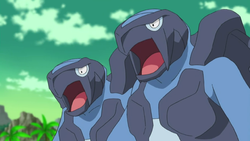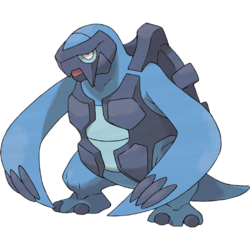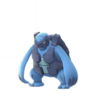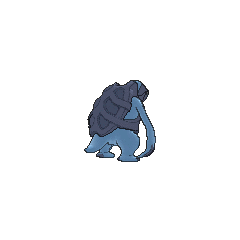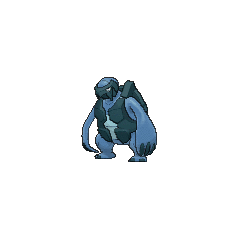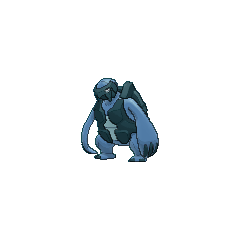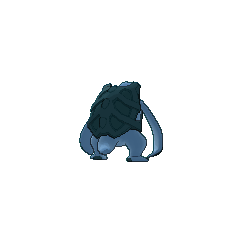Biology
Carracosta is a reptilian Pokémon resembling a bipedal, blue-colored sea turtle. Its stomach is pale blue. It has deep blue rocky structures encrusted on its face, back, and the sides of its chest forming a "mask" and shell. Its flippers are long with black finger-like protrusions at the tips. Carracosta has a thick tail and short legs with two-toed feet.
Carracosta's flippers are powerful; with one slap, it can open a hole in the bottom of a tanker or knock out a foe. It once lived in the sea millions of years ago and is now considered extinct. It hides in its shell to imitate a boulder to ambush prey. Carracosta has extremely strong jaws, allowing it to eat steel frames and rocks, in addition to prey, devouring every last piece of flesh and shell or bone. This diet allows Carracosta to develop a thick and sturdy shell. Carracosta is an active hunter on both land and sea. However, it moves slowly on land, so once it finds prey on land, Carracosta drags it into the water to finish it off. It preys on Omanyte and Omastar.
Evolution
Carracosta evolves from Tirtouga.
(For specifics on this Pokémon's evolution in the games, refer to Game data→Evolution data.)
Game data
NPC appearances
Pokémon Super Mystery Dungeon: Carracosta is the adoptive father of the partner Pokémon. He is stern and strict but means well.
Pokédex entries
| This Pokémon was unavailable prior to Generation V.
|
| Generation V
|
|
Unova
B W : #071
|
|
Unova
B2 W2 : #127
|
| Black
|
They can live both in the ocean and on land. A slap from one of them is enough to open a hole in the bottom of a tanker.
|
| White
|
Incredible jaw strength enables them to chew up steel beams and rocks along with their prey.
|
| Black 2
|
It could knock out a foe with a slap from one of its developed front appendages and chew it up, shell or bones and all.
|
| White 2
|
|
|
| Generation VI
|
|
Kalos
#—
|
|
Hoenn
#—
|
| X
|
They can live in the ocean and on land. A slap from one of them is enough to open a hole in the bottom of a tanker.
|
| Y
|
It could knock out a foe with a slap from one of its developed front appendages and chew it up, shell or bones and all.
|
| Omega Ruby
|
They can live both in the ocean and on land. A slap from one of them is enough to open a hole in the bottom of a tanker.
|
| Alpha Sapphire
|
It could knock out a foe with a slap from one of its developed front appendages and chew it up, shell or bones and all.
|
|
|
| Generation VII
|
|
Alola
S M : #195
|
|
Alola
US UM : #242
|
|
Kanto
#—
|
| This Pokémon has no Pokédex entries in Let's Go, Pikachu! and Let's Go, Eevee!.
|
| Sun
|
It constructed its sturdy shell by crunching and swallowing the hard shells or bones of its prey.
|
| Moon
|
Active both on land and in the sea, this Pokémon drags its land-based prey into the water to finish it off.
|
| Ultra Sun
|
Its jaws are terrifyingly powerful. It could eat Omastar and Omanyte whole and not be bothered in the slightest by their shells.
|
| Ultra Moon
|
Carracosta eats every last bit of the prey it catches, even the shells and bones, to further strengthen its sturdy shell.
|
|
|
| Generation VIII
|
|
Galar
Crown Tundra #148
|
|
Sinnoh
#—
|
|
Hisui
#—
|
| This Pokémon has no Pokédex entries in Brilliant Diamond, Shining Pearl, and Legends: Arceus.
|
| Sword
|
Carracosta completely devours its prey—bones, shells, and all. Because of this, Carracosta's own shell grows thick and sturdy.
|
| Shield
|
This Pokémon emerges from the water in search of prey despite the fact that it moves more slowly on land.
|
|
|
|
|
Game locations
| This Pokémon was unavailable prior to Generation V.
|
|
|
|
|
|
|
|
|
|
|
In side games
| This Pokémon was unavailable prior to Generation V.
|
|
|
|
|
|
|
| Generation VIII
|
|
| This Pokémon is unavailable in Generation VIII side games.
|
|
|
|
|
Stats
Base stats
| Stat
|
Range
|
| At Lv. 50
|
At Lv. 100
|
74
|
|
134 - 181
|
258 - 352
|
108
|
|
101 - 176
|
198 - 346
|
133
|
|
124 - 203
|
243 - 401
|
83
|
|
79 - 148
|
153 - 291
|
65
|
|
63 - 128
|
121 - 251
|
32
|
|
33 - 92
|
62 - 179
|
Total: 495
|
Other Pokémon with this total
|
- Minimum stats are calculated with 0 EVs, IVs of 0, and (if applicable) a hindering nature.
- Maximum stats are calculated with 252 EVs, IVs of 31, and (if applicable) a helpful nature.
|
Type effectiveness
| Under normal battle conditions in Generation IX, this Pokémon is:
|
|
|
|
|
|
|
|
|
|
|
|
|
Learnset
Carracosta is available in Sword and Shield Version 1.3.0+.
|
|
|
|
- Bold indicates a move that gets STAB when used by Carracosta
- Italic indicates a move that gets STAB only when used by an Evolution of Carracosta
- Click on the generation numbers at the top to see level-up moves from other generations
|
|
|
|
|
- Bold indicates a move that gets STAB when used by Carracosta
- Italic indicates a move that gets STAB only when used by an Evolution of Carracosta
- Click on the generation numbers at the top to see TM moves from other generations
|
|
|
|
|
- Moves marked with an asterisk (*) must be chain bred onto Carracosta in Generation VIII
- Moves marked with a double dagger (‡) can only be bred from a Pokémon who learned the move in an earlier generation.
- Moves marked with a superscript game abbreviation can only be bred onto Carracosta in that game.
- Bold indicates a move that gets STAB when used by Carracosta
- Italic indicates a move that gets STAB only when used by an Evolution of Carracosta
- Click on the generation numbers at the top to see Egg moves from other generations
|
|
|
|
|
- Bold indicates a move that gets STAB when used by Carracosta
- Italic indicates a move that gets STAB only when used by an Evolution of Carracosta
- Click on the generation numbers at the top to see Move Tutor moves from other generations
|
|
|
|
|
- Bold indicates a move that gets STAB when used by Carracosta
- Italic indicates a move that gets STAB only when used by an Evolution of Carracosta
- Click on the generation numbers at the top to see moves from other generations
|
By transfer from another generation
|
|
|
|
- Transferred Pokémon only retain these moves in Pokémon Sword and Shield
- A striped background indicates a generation in which the move can only be obtained via event or as a special move
- Bold indicates a move that gets STAB when used by Carracosta
- Italic indicates a move that gets STAB only when used by an Evolution of Carracosta
- × indicates a move that cannot be used in Sword and Shield
- Click on the generation numbers at the top to see transfer-only moves for other generations
|
Side game data
|
|
Pokémon Rumble Rush

|
Walking Speed: 1.42 seconds
|
Base HP: 54
|
|
| Base Attack: 79
|
Base Defense: 59
|
Base Speed: 60
|
|
|
|
|
|
|
|
|
Evolution data
Sprites
| This Pokémon was unavailable prior to Generation V.
|
|
|
|
|
|
|
| This Pokémon is unavailable in Generation IX.
|
|
|
In the animeIn the mangaIn the TCGTrivia
- Carracosta and its pre-evolved form are the only Fossil Pokémon to have Rock as their secondary type instead of their primary type.
- Before Generation VIII, Carracosta and its pre-evolved form had only been obtainable with their Hidden Ability in the Pokémon Dream World. Due to the closure of the Pokémon Global Link, they could no longer be obtained with their Hidden Ability, except by trading between games and breeding. The Tirtouga family's Hidden Ability can currently be obtained via the Ability Patch.
- Carracosta's English category, "Prototurtle", may be a combination of proto- (prefix used to mean "original" or "primitive" derived from an Ancient Greek word meaning "first") and turtle.
Origin
Carracosta appears to draw inspiration from Archelon, the largest known species of sea turtle from the Late Cretaceous period. Its blue skin and dark gray carapace give it the same color scheme as the leatherback sea turtle. The fact it eats steel beams draws from the fact that sea turtles can bend metal bars with their jaws. The front of its shell also bears resemblance to a bulletproof vest.
Name origin
Carracosta may be a combination of carapace (a hard, protective covering, i.e. a shell) and costa (Latin, Spanish and Portuguese for coast). It may also allude to the Carrara fossil formation, which contains numerous trilobite fossils.
Abagoura may be a combination of 暴れる abareru (to thrash or act violently) or 肋 abara (rib cage) and 甲羅 kōra (shell).
In other languagesRelated articlesExternal links

|
This Pokémon article is part of Project Pokédex, a Bulbapedia project that aims to write comprehensive articles on each Pokémon species, as well as Pokémon groups and forms.
|

 For other sprites and images, please see Carracosta images on the Bulbagarden Archives.
For other sprites and images, please see Carracosta images on the Bulbagarden Archives.